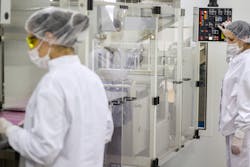Future Workers Still Have Misconceptions About Skilled Trade Jobs
Even if you believe something to be true, you might not follow that belief.
This is exactly the case based on the results from a recent survey from 3M called the State of Science Index. In its fifth year, the survey examines the public image of science globally. One of the themes of this year's survey was the perception of vocational skills. The survey found that a large number of Americans, 90%, believe that jobs in the skilled trades offer a lot of opportunities. But a majority, 71%, also said they would not pursue this employment route.
·
Why is this? Well, Mike Vale, group president of Safety and Industrial Business for 3M has some theories. “When we ask questions about skilled trade careers, people will say that while I see it as equivalent in pay, I have other things I'm more interested in. And when you get to the behavioral side, I feel that many parents will guide their kids into what they perceive as a more stable, higher-paying career path than what a skilled trade job could offer,” Vale explains.
Another issue is the perceived difficulty when it comes to identifying the different educational requirements. “Some confusion exists as to the difference between a four-year bachelor's degree in science, a four-year technical trade degree, and an associate degree in the trades, and what careers those degrees will lead to,” Vale says.
The survey supports his views with 94% of Americans agreeing the workforce needs more skilled trade workers, but 46% of those who don’t work in a skilled trade say following other passions is a top barrier to pursuing a trade career.
Money is always a concern, and perception remains a challenge. While 77% believe they would earn as much money in a skilled trade as they would in a career that requires a traditional 4-year degree, 14% of those who don’t work in a skilled trade say a top reason they didn’t pursue a trade skill was that they didn’t think they would make enough money.
And the ability to afford this type of training was an issue with 20% of those who don’t work in a skilled trade saying a top reason they didn’t pursue a trade skill was that they couldn’t afford a trade school to learn a skilled trade.
Part of this confusion around these jobs is the lack of knowledge about these careers and how to pursue them. And this education needs to be started very early. “We should be laying the foundation of science-related careers, even at the primary level,” says Vale. “Getting people excited about what science can do in terms of innovation and its practical application to solve society's problems and challenges, should begin as early as possible. You have to nurture kids and their curiosity and help them as they move through the advanced stages of education.”
3M is actively working to address this by reaching out to students of varying ages to educate them about opportunities in the field. Programs include:
3M Visiting Wizards which are 3M scientists and employees who volunteer their time to encourage young people to become interested in science and technology showcasing interesting and fun science demonstrations and hands-on experiments on a variety of topics.
3M TechTalks, involved 3M volunteers inspiring students to pursue STEM careers. These presentations broaden students’ understanding of what science and engineering careers are and help them see themselves as a scientist or engineer.
3M Science Training Encouragement Program (STEP) provides high school juniors and seniors of diverse backgrounds the opportunity to participate in the process of scientific discovery at one of the world’s leading corporations. Through mentoring by 3M volunteers, classroom instruction and summer experience in a 3M laboratory, 3M STEP students will learn, increase job skills, gain insight into scientific careers, and enhance their personal development.
The 3M Teachers Working in Science and Technology (TWIST) program invites middle and high school math, science and technology teachers to spend six weeks during the summer working closely with a 3M host on actual 3M research projects. This provides teachers an opportunity to get real-world STEM experience by working in 3M labs and manufacturing facilities and enhances their knowledge of how science is applied to life.
The 3M Manufacturing and Academic Partnerships (MAP) program, which introduces students to a career in manufacturing. Since 2017, 3M’s MAP program has provided grants to support a robust mechatronics curriculum in a growing number of high schools and technical colleges and has brought in 3Mers as guest educators and mentors.
The company is also focused on being inclusive in its efforts and has recently set a global education goal to create five million STEM and skilled trades learning experiences for underrepresented individuals by the end of 2025. “There has to be access to this type of education," explains Vale. "The survey found that underrepresented communities such as Hispanic and Black Americans face large barriers,” said Vale.
Skills Challenges
The need for a growing STEM workforce is exemplified by the continued digitalization in manufacturing. And one of the more advanced technologies in automation is artificial intelligence (AI). The survey asked about the perception of AI and received some interesting answers. Excitement over AI is not as high in the U.S. as it is globally and declines among older generations. While 59% of Americans believe AI is an exciting technology that impacts their life every day (vs. 65% globally), 35% of Americans feel AI will cause them to lose their jobs within the next five years. This worry is more prevalent in Millennials (54%) and Gen Z (50%) than in Gen X (37%) and Baby Boomers (16%).
Studies have shown that jobs will shift requiring different skills. While that will mean a loss of some jobs, it will also mean a gain of other types of jobs. And this is where upskilling comes in. The survey shows that upskilling is now expected of employers. Nearly nine in ten Americans (88%) believe employers should offer financial support or reimbursement to employees for upskilling.
“We have always had a strong program to help our employees meet their career goals and much of that has to do with education.” Says Vale. “Some of our production engineers move into associate degrees or other degrees while they are working and others go back to school full-time. We support whatever path the employees want. Everybody has different desires, and our approach is to be flexible and understand everyone’s priorities, goals, and desires, and help them the best we can."
Some of the specific programs the company uses to reach those goals are as follows:
- A commitment to helping employees find at least one hour per week to learn, with supervisors encouraging them to block time on their calendar.
- A team of learning partners for business groups and functions to connect learning needs to learning opportunities. The company is also working to provide personalized Learning Tracks that meet employees where they are and help them grow.
- Thousands of on-demand courses that employees can access at any time recommended courses and training, informal and formal mentorship programs, and a tuition reimbursement program.
A Broader View
The emphasis on career development is part of an overall culture that is based on purpose. “We always start with what is our purpose based on the history of our company. We believe our mission is to unlock people, science, technology, and innovation in order to reimagine what's possible. Some of the products that we produce solve the greatest problems that societies face either small or large.
“The most dramatic example of this was our N95 respirator production lines during the pandemic. People were very proud to work for the company. They care about what they are working on, and they care about the larger issues such as sustainability, diversity and inclusion. You have to build on those issues and that's where purpose, culture, and a company's mission start to make a difference.”

